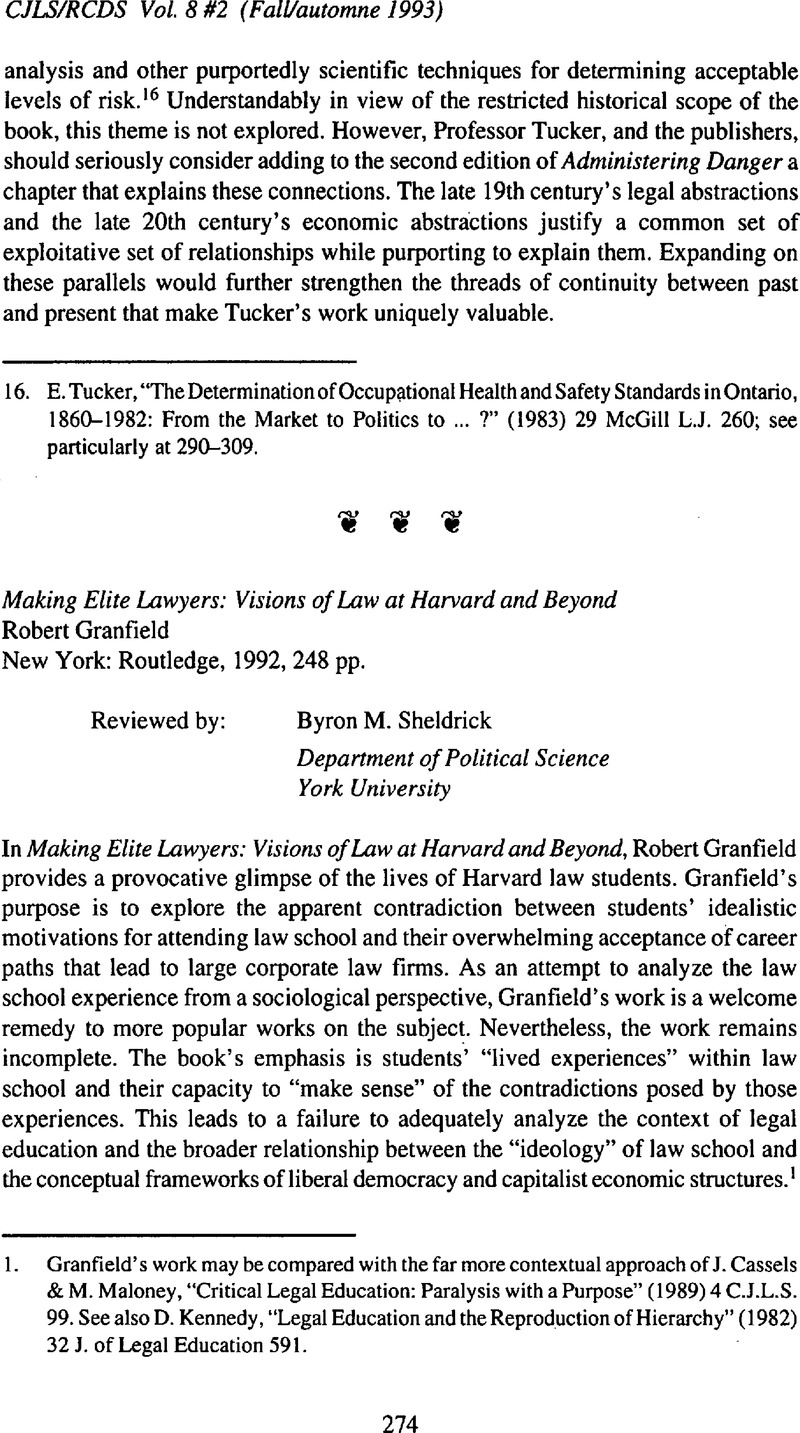No CrossRef data available.
Article contents
Making Elite Lawyers: Visions of Law at Harvard and Beyond, Robert Granfield, New York: Routledge, 1992, 248 pp.
Published online by Cambridge University Press: 18 July 2014
Abstract

- Type
- Reviews/Recensions
- Information
- Canadian Journal of Law and Society / La Revue Canadienne Droit et Société , Volume 8 , Issue 2 , Fall/automne 1993 , pp. 274 - 279
- Copyright
- Copyright © Canadian Law and Society Association 1993
References
1. Granfield's work may be compared with the far more contextual approach of Cassels, J. & Maloney, M., “Critical Legal Education: Paralysis with a Purpose” (1989) 4 C.J.L.S. 99CrossRefGoogle Scholar. See also Kennedy, D., “Legal Education and the Reproduction of Hierarchy” (1982) 32 J. of Legal Education 591Google Scholar.
2. Granfield gives an example of how the case method is utilized to remove social and political context from the consideration of cases. In particular, he argues that law students are urged to draw links between apparently disparate and unrelated cases. In this way, the technique of argumentation is divorced from context. The example Granfield uses, however, is instructive. He discusses an instance where the professor attempted to draw a connection between the loss of a limb and the failure to honor a contractual obligation. The damages for loss of a limb were to be calculated using the same economic model that would apply to any contractual situation. Granfield's point regarding how unrelated the two situations are is certainly valid. However, the utilization of an economic model as the dominant paradigm for consideration of other social problems is a vitally important element of legal consciousness that Granfield ignores. See Granfield, pp. 56–58.
3. See, for example, Cassels & Maloney, supra note 1 for a discussion of the barriers to introducing courses that discuss law from a critical, rather than doctrinal, perspective.
4. It is for this reason that the rise of law and economics programs, which seek to make the application of economic reasoning to law more explicit and universal, pose such a danger. The growth of these programs decreases the space for resistance within law schools by equating all law with a universal and totalizing utilitarian rationality.
5. Granfield bases his use of the terms “social” and “equity” feminists on the work of Naomi Black. See her Social Feminism (Ithaca: Cornell University Press, 1989)Google Scholar.
6. Compare, e.g., the statements by students found on pp. 98–99 with those on p. 104.
7. For example, only 15% of the upper- and middle-class students attending Harvard listed altruistic reasons as their primary motivation for attending law school, while 31% of working-class students cited such motivations. Granfield, p. 112.
8. Granfield's data indicate that career choices were ranked first by 40%, second by 45%, and third by 55% of students as the reason they attended law school. Altruistic reasons, on the other hand, were ranked first by 26%, second by 17%, and third by 18%. Granfield, p. 38.
9. Granfield's work is particularly disappointing regarding the problems of race. Given the pre-eminence of race within the political discourse of the United States, it is somewhat puzzling that he devotes no more than an occasional paragraph to the experiences of Afro-American students at Harvard.
10. See Pateman, C., Participation and Democratic Theory (Cambridge: Cambridge University Press, 1970)CrossRefGoogle Scholar for a classic discussion of democratic theory and a critique of elite-based models of democracy.
11. See Schumpeter, J., Capitalism, Socialism and Democracy (London: Allen and Unwin, 1943)Google Scholar.
12. For a discussion of how the competitive model of voter aggregation operates to remove the discussion of issues from electoral politics, see Clarke, H. et al. , Absent Mandate: The Politics of Discontent in Canada (Toronto: Gage, 1984)Google Scholar.
13. In the Canadian context, see Cassels & Maloney, supra note 1.
14. For an excellent discussion of how concepts of legal professionalism are both autonomous from and inextricably linked to broader social structures, see Bourdieu, P., “The Force of Law: Toward a Sociology of the Juridical Field” (1987) 38 Hastings L.J. 805Google Scholar.




